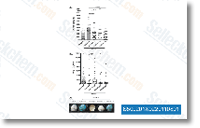gracilis hasn’t been reported to blood feed and no evidence of host blood or haematin was observed within the monogeneans all through this examine, and gill filaments from the fish within this review had been both damaging or only incredibly faintly constructive, when examined with all the unique PCR, primarily when in contrast to other internal tissues. This suggests that the monoge neans will not come to be contaminated by simply feeding from your mucus and gill epithelia of an infected fish. It is actually pos sible that monogeneans might ingest sporoplasms which have been launched from marine actinospores on the gill surface, prior to they enter the fish host. However, infec tion from the monogeneans is histozoic and never limited to a superficial advancement from the anterior digestive organ in which fish materials can be existing, if it had been necessary for growth to happen.
Moreover, myxospores usually are not detectable during the fish host implying that full development may not arise while in the fish, building selleck inhibitor it a dead finish host without any transmission poten tial for that myxosporean. Therefore, an choice sce nario may very well be that the fish has tiny to carry out with the infection or the transmission of your myxosporean para website, but is just getting exposed on the similar actinos pore phases of this parasite. Occurrence while in the blood filtering tissues like kidney and spleen, too as during the gastrointestinal tract supports this plan. The fish is exposed and also the parasite can penetrate the integument, but growth in the fish is stopped, the monoge neans merely turn out to be infected by grazing launched sporo plasms to the gill surface.
Presently, the partnership among the fish as well as monogenean as well as the dynamics of the myxosporean infection usually are not absolutely understood. Nevertheless, myxos pores using a Myxidium like morphology are already reported to create in three distinctive gill monogeneans infecting 3 distinctive host fish. DNA data exists for two of those myxosporean hyperparasites and they’re phylogenetically relevant. order inhibitor Within the third situation, from European eels contaminated with two species of Pseudodacty logyrus, clear host specificity was observed, wherever one particular species, P. bini, was uncovered to get a higher prevalence of infection together with the myxosporean as well as the other, P. anguil lae, was completely uninfected. These facts verify that gill monogeneans are accurate hosts for myxosporeans, but it stays to be clarified how this really is related to infections during the fish.
Molecular phylogenetics The SSU rDNA of M. incomptavermi was somewhat brief at 1702 bases, but is consistent with phylogeneti cally connected multivalvulidan taxa. From the phylogenetic analyses, irrespective of your tree constructing methodology made use of, M. incomptavermi is persistently and robustly positioned  at the base of the multivalvulidan clade along with the hyperparasitic Myxidium sp.
at the base of the multivalvulidan clade along with the hyperparasitic Myxidium sp.
No related posts.
